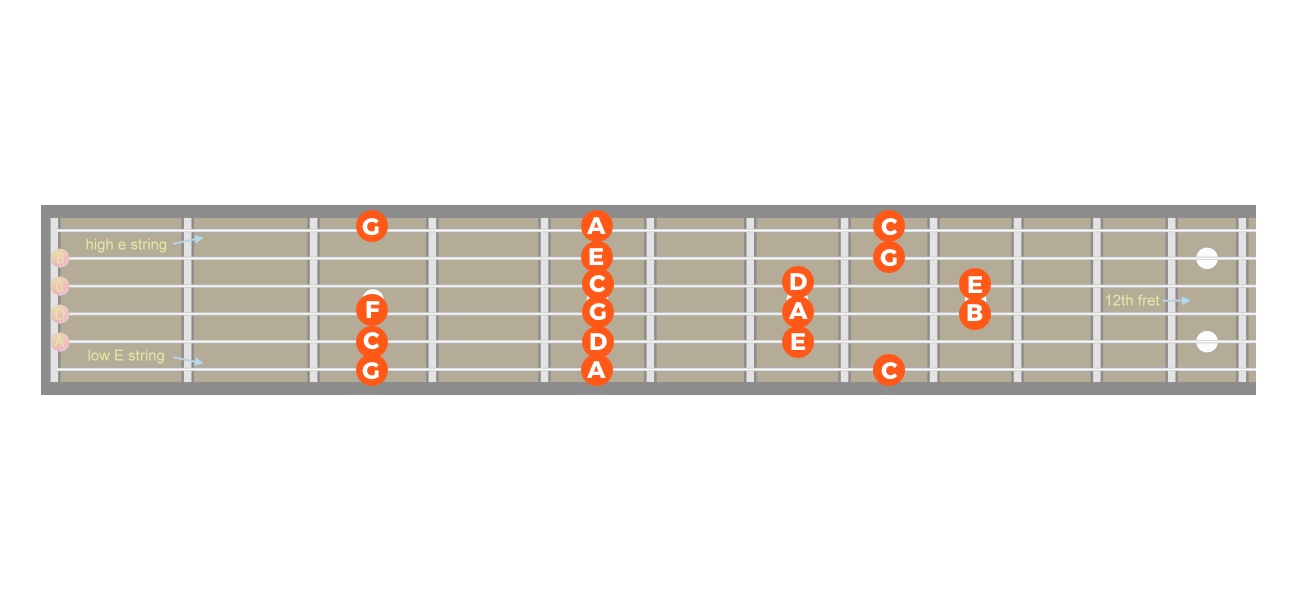The Notes on the Fretboard
So before we look at this, you need to make sure you have read through The Musical Alphabet first, otherwise this might sound like another language!
We need to make sure we understand the notes in the musical alphabet. Once you know the order of the notes, we can put them on to the guitar neck and find our way around the maze of the guitar neck!
Knowing the musical alphabet is very important we can use this to work out what note we are on if we know the order of the strings. Before we g any further, make sure you understand this!
If we start with the Low E string, starts on the E note of our musical alphabet. The next note up is F, and this note is a semi-tone.
So when we start on an E string, add 1 fret on that string and we get the F note. Whenever we move up or down 1 fret, we are moving up or down a semitone.Knowing your musical alphabet is so important, I cannot stress this enough! Learn it like you know your name, because it will make your life so much easier when playing!
But using this technique will give us an overwhelming amount of notes to remember. So how do we get through it without analysing every fret on the guitar?
Well a very easy way to learn the notes on the fretboard is by using "Anchor" notes. These are notes that are easier to remember, and can be used as a reference to more notes. For example:
One of my anchor notes is on the 3rd fret of the A string. I have memorised that as C. Whenever I need to play a D, I can think of my memorised anchor notes and start there. Then work out how far away D is from C (a tone) and then I count up from it. The same goes with Bb. I know C is nearby, so I start with C, then move down until I find Bb.
The more of these anchor notes you can memorise, the easier it will be to find notes on the fret board.
A patten that I find easy to remember looks like the one below:
It might not look like all the notes on the fretboard but it covers a large area of it.
If you breakdown the musical alphabet in to the natural notes only, they line up perfectly well with the marked frets. If we start on the A string 3rd fret, we get C. We can use frets 3, 5, 7 for C, D, and E.
On the next string, we start on frets 3, 5, 7, 9 and have F, G, A , B
Then we repeat the alphabet again, this time, starting with the 5th fret on the G string. on frets 5, 7, and 9 we have C, D, and E.
Learning these frets and this pattern will help you get through a large chunk of the note names on the fretboard. All we have to do when we have memorised our anchor notes is to work out where the sharps and flats go, but this should be easy as we have gone through the alphabet already.
The only ones left to tackle are the E string, and B string.
To memorise the E string, you could use the 5th fret as A, and the 7th fret as C. That covers the top and bottom strings, and for the B string you can use the 5th fret as E, and the 8th fret as G.

And that is an easier way to remember the notes on the strings. My advice is take it slow with this. Start out with 1 string and get used to saying the note names out loud. When you say them out loud, you will be more likely to remember them. Move on the the next string when you are happy, and call each note out. When you can do this on all the strings, test yourself by changing to different notes and saying the note names.



